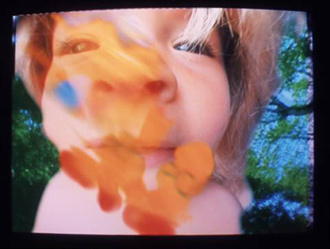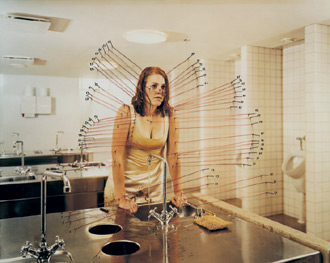Richard Wentworth Born Samoa 1947 - lives and works in London

Richard Wentworth, from Making Do and Getting By
" Richard Wentworth is one of the generation of younger, internationally acclaimed British sculptors who have fundamentally altered traditional definitions and perceptions of sculpture. His work allows us to recreate our perception of the world by forcing us to reappraise the objects with which we are surrounded. He has said 'I live in a ready-made landscape and I want to put it to work': he takes manufactured objects and re-presents them, stretching affinities and creating unions with fresh elements. The object and our perception of it are thus fundamentally reconceived."
http://www.site-walsall.co.uk/square1/rw_cont.htm

Richard Wentworth, from Making Do and Getting By
Introduction to 2001 exhibition at the Photographer's Gallery:
"In this unusual exhibition, Richard Wentworth's extraordinary series of photographs Making Do and Getting By(1974-2001), is brought into dialogue with the work of Frenchman, Eugène Atget, a figure who stands at the beginning of thinking about photography and Modernism.
Both Atget and Wentworth are authors of photographic compendia which describe the great cities of London and Paris poised at two very different moments of change - at the twentieth century's beginning and at its end. For both, the city is a vivid yet fugitive place, continually undergoing cycles of renovation, disintegration and renewal once more. Its pavements are a 'stage' for social activity, and its physical details, however fleeting, full of meaning about the nature of an urban society - and what the individuals within it, own, do, make and improvise.
In the last decade of the nineteenth century, Eugène Atget (1857-1927), a repertory actor with a flagging career, turned to photography. Over the next thirty years, he produced an inexhaustible stream of photographs documenting every corner of a Paris entering the new century. With the intention of selling his 'documents' to painters, set designers and craftsmen, Atget built up a massive inventory - some 8,500 photographs - of the city's streets, alleys, shopfronts, and peripheral zones: street by street, building by building, door knocker by door knocker. He divided his work into 13 categories - among them the ambulatory street traders of Paris (plate menders, lampshade makers, baguette sellers); the vehicles of the city (59 horse-drawn contraptions and one steam-roller); domestic interiors across the class spectrum (including his own which he coyly described as the home of 'Mr R, dramatic artist'), and the glazed shop fronts and mannequin-filled displays that were to so enthuse the Surrealists.
Although separated by a century in time, it is perhaps not so far from Atget's extraordinary Zoniers album - photographs of the colony of ragpickers and scrap merchants living in shanty towns on the edge of Paris - to Richard Wentworth's scrap-sifting street traders on the Caledonian Road. Both squeeze the last drops of economic value from objects which might be deemed commodities in the morning, and rubbish by evening. It is this battle with utility which intrigues Wentworth, as he documents objects which may have failed in one function, only to find an entirely new one - like the leaky wellington boot now adapted into a perfect door wedge, or the finger of fudge which stops the school bell ringing.
It is the 'manners' of the street which absorb Wentworth. Those manners are manifest in the language it speaks, in the form of helpfully scrawled signs - 'Press for long time', a home-owner has written, encouragingly, by their doorbell. It is in those final 'gestures of politeness', which prevent someone dropping their half-eaten sandwich on the ground, and decide instead to tuck it in the craw of a tree. Or the infectious behaviour that spreads in the streets, when, for instance, one person's discarded coke can, is joined by another and another...
Wentworth, like Atget, rarely photographs people, and yet his world is human, all the more human, for being uninhabited. Whether in his gentle anthropomorphism - a decrepit car, its drooping bumper bandaged with carpet as if wounded - or in his alertness to the practical, yet curious decisions made when dealing with the vicissitudes of life - like the hurried shopper who abandons his dog in the street, chained, not to the railings, but to his shoulder bag - Wentworth's photographs make us look afresh at the cityspace and the humanity it contains."
Kate Bush, Senior Programmer
http://www.absolutearts.com/artsnews/2001/10/06/29200.html

Richard Wentworth, from Making Do and Getting By
Tuesday October 9, 2001 _ _ _ article in The Guardian
Snap, crackle and pop
'Connections are made, broken, remade, lost and found again'... Adrian Searle on two photographers who capture the ramshackle, makeshift chaos of city life
Since 1974, the sculptor Richard Wentworth has been taking a series of photographs called Making Do and Getting By. You could describe the photos as a visual notebook, or even as a small anthropological investigation. Whether they have been taken on the hoof through London or Istanbul, their subjects are consistent. What the images record are small moments of human ingenuity, vivid yet ephemeral disruptions of the commonplace, breaks in the order of things.
Wentworth has always been interested in our relationship with "things" - with the world of use, overproduction, disposability. This doesn't mean just the stuff we keep in our pockets or in a drawer, but cars, wardrobes, doors, buildings, walls, the streets themselves. He records our improvisatory negotiations with a recalcitrant world. The objects in the images fall loosely into categories of acts: piling, propping, wedging and leaning. Many of Wentworth's photos also focus on more or less startling displacements, what might almost be misuses, even abuses.
A door wedged open with a gumboot, the clapper of an alarm bell silenced with a Fudge bar still in its wrapper, a catering-size tin of peas used as a cafe doorstop. These kind of uses have always been the mainstay of Making Do, but many other photographs are less to do with the utilitarian, and more to do with the happenstance arrangements of things, or ad hoc kinds of display, especially the pavement displays of second-hand furniture outside the junk shops of Caledonian Road in north London. Rows of old armchairs lined up by a bus stop, vacant sofas at the kerb, upended chairs like fallen men.
What is there to connect Wentworth with Eugène Atget, both of whose works are on show at London's Photographers' Gallery? They occupy adjacent rooms and different epochs. The Atgets - which mostly date from the turn of the last century - sit in dim light, framed and fading. The Wentworths are perched on a shelf which runs around the walls of a brightly lit room. Contrast and compare, the exhibition seems to say.
From the late 1880s until the 1920s, Atget wandered Paris, photographing the streets, doorways, facades and shop signs of the city. His photographs are mostly unpeopled. It is not that his Paris is deserted - just that the humans do not linger for enough time in the long exposures of his camera to be much more than a fleeting blur. Sometimes we catch a glimpse of the photographer, but only as a shadow on a wall, or a presence reflected in a shop window or mirror.
The dates of Atget's pictures tell us something of how the photographer crossed and recrossed Paris, sometimes returning to the same corner, the same address, years - sometimes decades - apart, to photograph the same subject from a slightly different angle, in a different light. Atget was taken up by the surrealists, but insisted that his images of shop-window dummies be reproduced anonymously. He did not, publicly at least, conceive of himself as an artist.
Wentworth, on the other hand, most certainly is an artist, of the most self-conscious sort, whose works might be seen as having been born under the sign of Marcel Duchamp. Atget spoke of himself as an "archivist" and called his photographs mere "documents". Man Ray had Atget as an interesting "primitive", yet there is nothing remotely primitive in Atget's talent.
John Szarkowski, for 30 years director of the photography department at New York's Museum of Modern Art, writes in a recent book that it was Atget's "recognition of the endless plasticity of the world that enabled him to return... to the same motifs, knowing that they would always be anew". It is this recognition of "endless plasticity" that unites Atget and Wentworth. Apart from the fact that both artists' images are the result of their wanderings around cities, they have little else in common.
I enjoy their work, but for very different reasons. Wentworth's images do not have the density and richness of Atget's, from which Szarkowski teases an entire world, making a point about Atget that also applies to Wentworth: "In an ideal world there is a place for everything, but in the real world things tend to migrate to places where they do not belong."
And so we find, among Wentworth's discoveries, a wine glass upended on the cast-iron spike of some railings, a car seat wedged in a plastic dustbin. We might groan at these examples of the out-of-place, but they have a kind of abject poetry. It is impossible not to be aware of Wentworth's self-conscious artist's eye, his sculptor's feel for things - how things are piled, or angled, how the plastic cups are crumpled and stuffed into the space between wall and drainpipe. He notices things that look like his sculptures, which seem to operate by the same organisational principles.
For Atget, everything is in his photographs, even if his ultimate intentions were more shadowy. Many of his images - over 8,500 of them - were made to be sold to architects, designers, artists, archives. But the thing about Atget is that there is more going on in the photograph, and in the world, than the superficial record of a thing or a place. Exactly where he places himself, framing the shot, is of absolute importance. This is not so with Wentworth. What Atget's camera captures is more than an intention, more than evidence.
Wentworth's images cannot haunt you the way an Atget can. The mis-aligned chequerboard lino in a Bloomsbury kitchen has none of the intensity of the ex-Austrian ambassador's rococco apartment. But it isn't just the content of the photograph that counts, it is the viewpoint, the arrangement. Faster, more portable cameras, have changed the tenor and the tempo of photography. Wentworth, I feel, in common with many photographers, shoots from the hip, kerb-crawling his subjects, on his way to somewhere else.
Wentworth photographs junk stalls and pavement furniture displays, as Atget did sometimes, but is there anything in Wentworth to match Atget's streets, alleys, doorways and facades? I don't think so. You can consume a Wentworth. Atget consumes you. And yet perhaps Wentworth and Atget are interested in something similar here - not so much in strata of muck piled in the streets, nor the stratification of society, but in another kind of layering of the world: how things go into freefall, how connections are made, broken, remade, lost and found again. This is how city life is. This is where we lose and find ourselves at every turn, chasing the ghosts of past selves. If this exhibition has a lesson, that is it.
http://www.guardian.co.uk/arts/critic/feature/0,1169,728547,00.html









